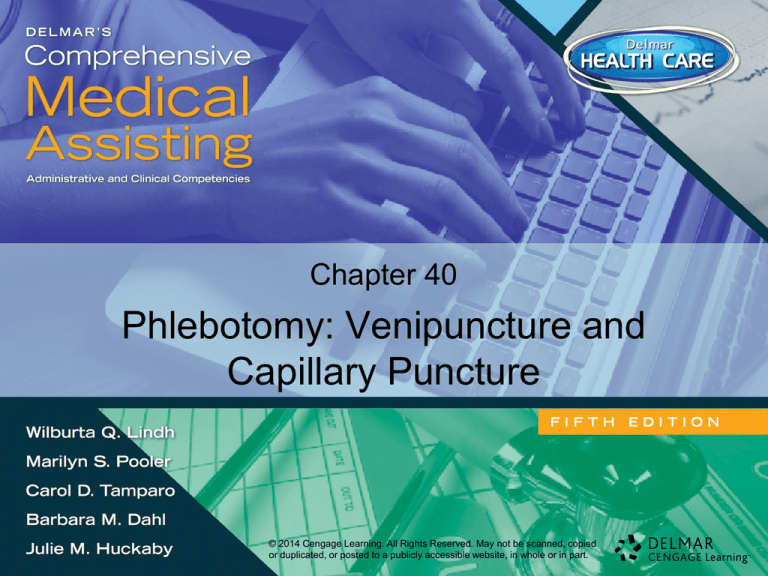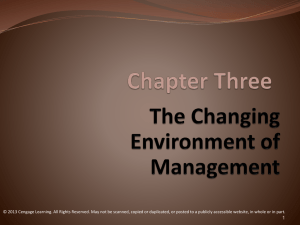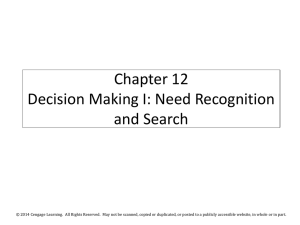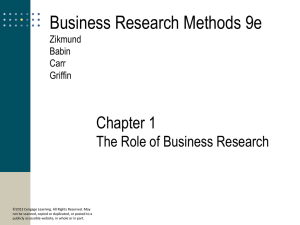
Chapter 40
Phlebotomy: Venipuncture and
Capillary Puncture
© 2014 Cengage©Learning.
2014 Cengage
All Rights
Learning.
Reserved.
All Rights
May not
Reserved.
be scanned,
May not
copied
be scanned, copied
or duplicated, or or
posted
duplicated,
to a publicly
or posted
accessible
to a publicly
website,
accessible
in wholewebsite,
or in part.
in whole or in part.
Why Collect Blood?
• Phlebotomy: for diagnostic purposes or
bloodletting as therapeutic measure
• Bloodletting dates to ancient Egyptians
• Phlebotomy historically used to cure
patients with “bad” blood
• Also called venipuncture
© 2014 Cengage Learning. All Rights Reserved. May not be scanned, copied
or duplicated, or posted to a publicly accessible website, in whole or in part.
The Medical Assistant’s
Role in Phlebotomy
• To collect blood as efficiently as
possible for accurate and reliable test
results
• Role varies
• Direct contact with patient
• Provide high-quality care
• Must act professionally
© 2014 Cengage Learning. All Rights Reserved. May not be scanned, copied
or duplicated, or posted to a publicly accessible website, in whole or in part.
Anatomy and Physiology
of the Circulatory System
• Blood forms in body’s organs and bone
marrow
• Blood carries oxygen and nutrients to
cells and removes waste products and
carbon dioxide
• Please see the Animations/Videos
button to view the clip.
© 2014 Cengage Learning. All Rights Reserved. May not be scanned, copied
or duplicated, or posted to a publicly accessible website, in whole or in part.
Anatomy and Physiology
of the Circulatory System
•
•
•
•
Heart: pumps blood through body
Arteries: blood flows away from heart
Veins: blood flowing back to heart
Capillaries: connecting most arteries
and veins
© 2014 Cengage Learning. All Rights Reserved. May not be scanned, copied
or duplicated, or posted to a publicly accessible website, in whole or in part.
Anatomy and Physiology
of the Circulatory System
• Arteries
– Carry blood from heart, carry oxygenated blood
(except pulmonary artery)
– Normally bright red in color
– Elastic walls that expand with surge of blood
– No valves
– Can feel a pulse
© 2014 Cengage Learning. All Rights Reserved. May not be scanned, copied
or duplicated, or posted to a publicly accessible website, in whole or in part.
Anatomy and Physiology
of the Circulatory System
• Veins
– Carry blood to heart, carry deoxygenated blood
(except pulmonary vein)
– Normally dark red in color
– Thin walls/less elastic
– Valves
– No pulse
© 2014 Cengage Learning. All Rights Reserved. May not be scanned, copied
or duplicated, or posted to a publicly accessible website, in whole or in part.
Anatomy and Physiology
of the Circulatory System
• Body contains about 6 liters of blood
• 45% of blood is formed elements
– Erythrocytes
– Leukocytes
– Thrombocytes (platelets)
© 2014 Cengage Learning. All Rights Reserved. May not be scanned, copied
or duplicated, or posted to a publicly accessible website, in whole or in part.
Anatomy and Physiology
of the Circulatory System
• 55% of blood is liquid
• 2.5 milliliters (mL) blood will yield about
1 mL serum
• Liquid part of blood is plasma
• Clotting converts fibrinogen into fibrin
© 2014 Cengage Learning. All Rights Reserved. May not be scanned, copied
or duplicated, or posted to a publicly accessible website, in whole or in part.
Anatomy and Physiology
of the Circulatory System
• Centrifuge separates serum from blood
• Vacuum collection tubes showing serum and
plasma
• Anticoagulant prevents blood from clotting
• Buffy coat: leukocytes and thrombocytes
© 2014 Cengage Learning. All Rights Reserved. May not be scanned, copied
or duplicated, or posted to a publicly accessible website, in whole or in part.
Blood Collection
• Most laboratory tests performed on
serum, plasma, or whole blood
• Serum sample: serum separator
vacuum tube with thixotropic gel used
• Do not use serum separator tubes for
therapeutic drug monitoring (TDM) or
toxicology studies
© 2014 Cengage Learning. All Rights Reserved. May not be scanned, copied
or duplicated, or posted to a publicly accessible website, in whole or in part.
Blood Collection
• Plasma and whole-blood collection
– Tubes containing anticoagulants used
– Preparing plasma specimen for transport or
testing similar to serum preparation
© 2014 Cengage Learning. All Rights Reserved. May not be scanned, copied
or duplicated, or posted to a publicly accessible website, in whole or in part.
Blood Collection
• Collection of blood specimens
–
–
–
–
–
–
Venipuncture commonly used method
Antecubital area
Median cubital vein
Superficial veins in hands or wrist
Veins in feet or legs
Arteries of arms
© 2014 Cengage Learning. All Rights Reserved. May not be scanned, copied
or duplicated, or posted to a publicly accessible website, in whole or in part.
Venipuncture Equipment
• Syringes and needles
– Syringes usually made of plastic
– Vary in size from 1 mL to 10 mL; Luer-Lok tip
– Needles attach to syringes
© 2014 Cengage Learning. All Rights Reserved. May not be scanned, copied
or duplicated, or posted to a publicly accessible website, in whole or in part.
Venipuncture Equipment
• Syringes and needles
– Needles vary in gauge and length
– Special needle; multidraw needle
– Winged infusion set (butterfly) with safety needle
© 2014 Cengage Learning. All Rights Reserved. May not be scanned, copied
or duplicated, or posted to a publicly accessible website, in whole or in part.
Venipuncture Equipment
• Safety needles and blood collection systems
– OSHA requires safety needles
– Prevent on-the-job needlestick injuries
– Needlestick prevention devices (NPDs)
© 2014 Cengage Learning. All Rights Reserved. May not be scanned, copied
or duplicated, or posted to a publicly accessible website, in whole or in part.
Venipuncture Equipment
• Vacuum tubes and adapters/holders
– Vacuum tubes: vacuum-packed test tubes with
rubber stoppers
• Plain or with added chemicals or substances necessary
for appropriate test to be run
– Plastic holders or tube adapters used in
conjunction with vacuum tubes
© 2014 Cengage Learning. All Rights Reserved. May not be scanned, copied
or duplicated, or posted to a publicly accessible website, in whole or in part.
Venipuncture Equipment
• Anticoagulants, additives, and gels
– Different tests require different types of blood
specimens
– Additive:
• Anticoagulant to prevent clotting of blood
• Chemical to help preserve blood
• Substance to accelerate clotting process
© 2014 Cengage Learning. All Rights Reserved. May not be scanned, copied
or duplicated, or posted to a publicly accessible website, in whole or in part.
Venipuncture Equipment
• Anticoagulants, additives, and gels
– Gel plugs: act as separators between blood
cells/clot and serum/plasma
– Anticoagulant: chemical substance that prevents
clotting; identified by tube color
– Clot activators: silica particles on sides of the
tubes that initiate clotting process
© 2014 Cengage Learning. All Rights Reserved. May not be scanned, copied
or duplicated, or posted to a publicly accessible website, in whole or in part.
Venipuncture Equipment
• Anticoagulants, additives, and gels
– When centrifuged, gel changes to liquid
– Gel forms solid plug and separates cells/clot from
plasma/serum
Separator thixotropic
gel tube>>
© 2014 Cengage Learning. All Rights Reserved. May not be scanned, copied
or duplicated, or posted to a publicly accessible website, in whole or in part.
Venipuncture Equipment
• Order to draw
– Revised Order of Draw published in 2003 by CLSI
and is still the standard
– Sterile collection bottles need to be filled first to
prevent any contamination
– After sterile culture tubes drawn, order for other
tubes is related to additives in them
© 2014 Cengage Learning. All Rights Reserved. May not be scanned, copied
or duplicated, or posted to a publicly accessible website, in whole or in part.
Venipuncture Equipment
• Tourniquets
– Constrict flow of blood in arm
– Make veins more prominent
– Rubber or elastic strip 1 inch wide by 15–18
inches long
– Blood pressure cuff may be used instead
© 2014 Cengage Learning. All Rights Reserved. May not be scanned, copied
or duplicated, or posted to a publicly accessible website, in whole or in part.
Venipuncture Equipment
• Specimen collection trays
– Hold all equipment necessary
– Portable
© 2014 Cengage Learning. All Rights Reserved. May not be scanned, copied
or duplicated, or posted to a publicly accessible website, in whole or in part.
Venipuncture Technique
• Approaching the patient
– Social skills
– Technical skills
– Administrative skills
© 2014 Cengage Learning. All Rights Reserved. May not be scanned, copied
or duplicated, or posted to a publicly accessible website, in whole or in part.
Venipuncture Technique
• Preparing supplies and greeting the
patient
– Prepare before venipuncture
– Place all tubes within easy reach
– Keep spare tubes
© 2014 Cengage Learning. All Rights Reserved. May not be scanned, copied
or duplicated, or posted to a publicly accessible website, in whole or in part.
Venipuncture Technique
• Patient and specimen identification
– Ask patient to state full name
– Check wristband if applicable
– Label specimen tubes before leaving examination
room
– Check paperwork against tubes
© 2014 Cengage Learning. All Rights Reserved. May not be scanned, copied
or duplicated, or posted to a publicly accessible website, in whole or in part.
Venipuncture Technique
• Patient and
specimen
identification
Computer label >>
Aliquot specimen>>
© 2014 Cengage Learning. All Rights Reserved. May not be scanned, copied
or duplicated, or posted to a publicly accessible website, in whole or in part.
Venipuncture Technique
• Positioning the patient
– Comfortable for patient and health care
professional
• Selecting the appropriate venipuncture
site
–
–
–
–
Antecubital
Back of hand
Back of wrist (can be painful)
Ankle or foot (provider permission needed)
© 2014 Cengage Learning. All Rights Reserved. May not be scanned, copied
or duplicated, or posted to a publicly accessible website, in whole or in part.
Venipuncture Technique
• Applying the tourniquet
– Applied 3 to 4 inches above intended puncture site
– Tightly enough to slow flow of blood in veins but
not so tightly as to prevent flow of blood in arteries
– On arm no longer than 1 minute
– Remove as soon as blood flow established
© 2014 Cengage Learning. All Rights Reserved. May not be scanned, copied
or duplicated, or posted to a publicly accessible website, in whole or in part.
Venipuncture Technique
• Performing a safe venipuncture
–
–
–
–
–
Find site that will give best blood return
Palpate vein with tip of index finger
Differentiating between veins, tendons, nerves
Use tourniquet appropriately
Avoid scars and compromised arms
© 2014 Cengage Learning. All Rights Reserved. May not be scanned, copied
or duplicated, or posted to a publicly accessible website, in whole or in part.
Specimen Collection
•
•
•
•
•
•
•
Hand washing critical step
Tie tourniquet
Select a vein
Cleanse site firmly with alcohol pad
Allow area to air dry
Put on gloves
Palpate vein
© 2014 Cengage Learning. All Rights Reserved. May not be scanned, copied
or duplicated, or posted to a publicly accessible website, in whole or in part.
Specimen Collection
• The syringe technique
– Ideal for collecting small volumes of blood from
fragile, thin, or “rolling” veins
– Blood placed in appropriate containers
– Order of filling the tubes important
– Use a safety system
© 2014 Cengage Learning. All Rights Reserved. May not be scanned, copied
or duplicated, or posted to a publicly accessible website, in whole or in part.
Specimen Collection
• The syringe technique
Proper hand position to hold syringe >>
© 2014 Cengage Learning. All Rights Reserved. May not be scanned, copied
or duplicated, or posted to a publicly accessible website, in whole or in part.
Specimen Collection
• The syringe technique
– After drawing blood into syringe, activate needle’s
safety mechanism, then remove needle and
dispose
– Connect needleless syringe to transfer device
– Insert vacuum tube to device
– Allow blood to transfer from syringe to tube
– After filling, mix any tubes containing additives
© 2014 Cengage Learning. All Rights Reserved. May not be scanned, copied
or duplicated, or posted to a publicly accessible website, in whole or in part.
Specimen Collection
• Vacuum tube
specimen
collection
– Improvement over
syringe method with
only slight variations
– Vacuum already in
tube
<<Proper hand position
© 2014 Cengage Learning. All Rights Reserved. May not be scanned, copied
or duplicated, or posted to a publicly accessible website, in whole or in part.
Specimen Collection
• Butterfly needle collection system
– Combines benefits of syringe and vacuum tube
methods
– Used for small and fragile veins that are difficult to
puncture
– Winged needle inserted at 5- to 10-degree angle
then threaded into vein
– Works well on children
© 2014 Cengage Learning. All Rights Reserved. May not be scanned, copied
or duplicated, or posted to a publicly accessible website, in whole or in part.
Specimen Collection
• Blood cultures
– Use surgical solution rather than alcohol
– Use sterile techniques
– Blood collected into special transport bottles
• Aerobic bottle filled first, then anaerobic
© 2014 Cengage Learning. All Rights Reserved. May not be scanned, copied
or duplicated, or posted to a publicly accessible website, in whole or in part.
Specimen Collection
• Patient reactions
– Vary
– MA must anticipate reactions and respond
appropriately
– If pain persists, discontinue venipuncture
© 2014 Cengage Learning. All Rights Reserved. May not be scanned, copied
or duplicated, or posted to a publicly accessible website, in whole or in part.
Specimen Collection
• The unsuccessful venipuncture
– Stimulate the vein
– Change position of needle by rotating needle half
a turn
– Advance further into vein
– Pull back a little
– Try another tube
© 2014 Cengage Learning. All Rights Reserved. May not be scanned, copied
or duplicated, or posted to a publicly accessible website, in whole or in part.
Specimen Collection
• The unsuccessful venipuncture
–
–
–
–
Withdraw needle slowly
Probing of site not recommended
After two attempts, have someone else try
Notify patient’s provider if two MAs unsuccessful
© 2014 Cengage Learning. All Rights Reserved. May not be scanned, copied
or duplicated, or posted to a publicly accessible website, in whole or in part.
Specimen Collection
• Criteria for rejection of a specimen
– Quality-assurance controls for specimen collection
and processing
– Retesting specimen or collecting another sample
© 2014 Cengage Learning. All Rights Reserved. May not be scanned, copied
or duplicated, or posted to a publicly accessible website, in whole or in part.
Specimen Collection
• Factors affecting laboratory values
– Improper specimen handling and storage
– Patient physiologic factors may contribute to
inaccurate results
– Special handling requirements not met
– Patient alters results by certain actions
© 2014 Cengage Learning. All Rights Reserved. May not be scanned, copied
or duplicated, or posted to a publicly accessible website, in whole or in part.
Capillary Puncture
• Method of obtaining one to several
drops of blood
• Tests that use blood obtained by
capillary puncture
–
–
–
–
CBC, RBC, and WBC
Hemoglobin and hematocrit
Glucose testing
Phenylketonuria testing
© 2014 Cengage Learning. All Rights Reserved. May not be scanned, copied
or duplicated, or posted to a publicly accessible website, in whole or in part.
Capillary Puncture
• Capillary blood collection sites
© 2014 Cengage Learning. All Rights Reserved. May not be scanned, copied
or duplicated, or posted to a publicly accessible website, in whole or in part.
Capillary Puncture
• Preparing capillary
puncture site
– Promoting circulation
Cleaning and disinfecting
>>
© 2014 Cengage Learning. All Rights Reserved. May not be scanned, copied
or duplicated, or posted to a publicly accessible website, in whole or in part.
Capillary Puncture
• Performing the puncture
– Wear appropriate PPE
Perform puncture in one quick,
steady movement >>
– Wipe away first drop of blood
Collect in capillary tubes or other
capillary collection device >>
© 2014 Cengage Learning. All Rights Reserved. May not be scanned, copied
or duplicated, or posted to a publicly accessible website, in whole or in part.








